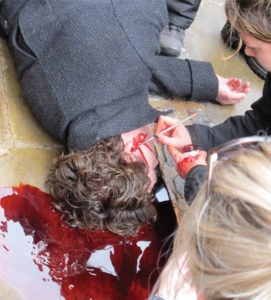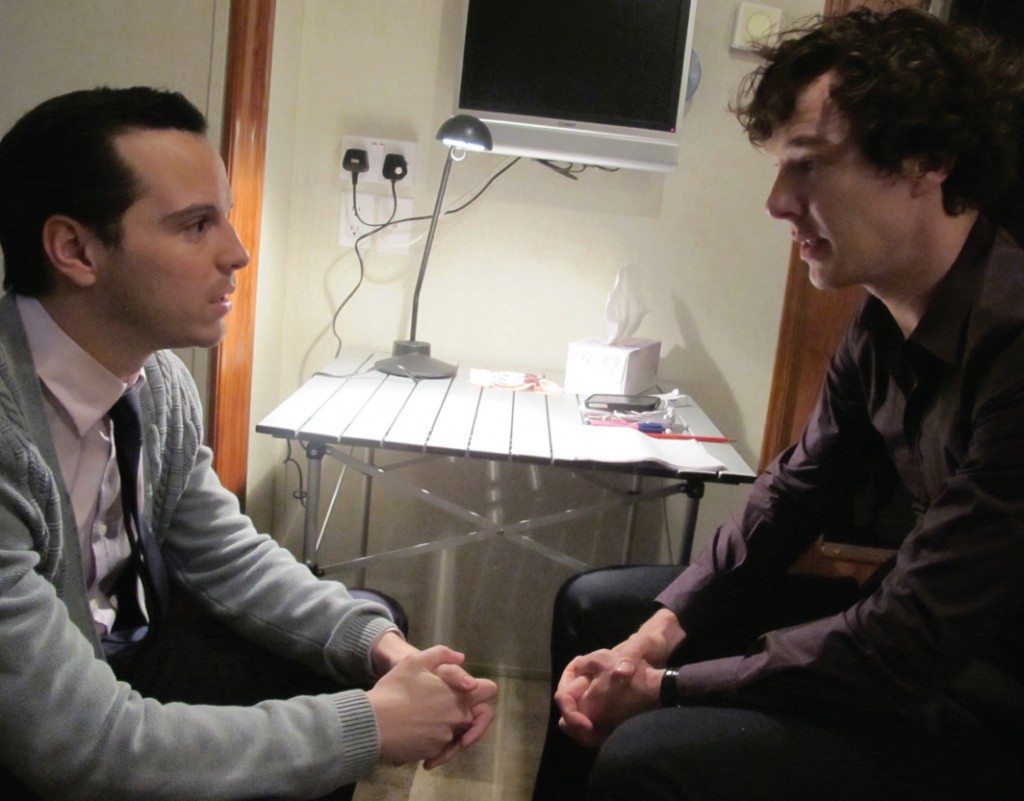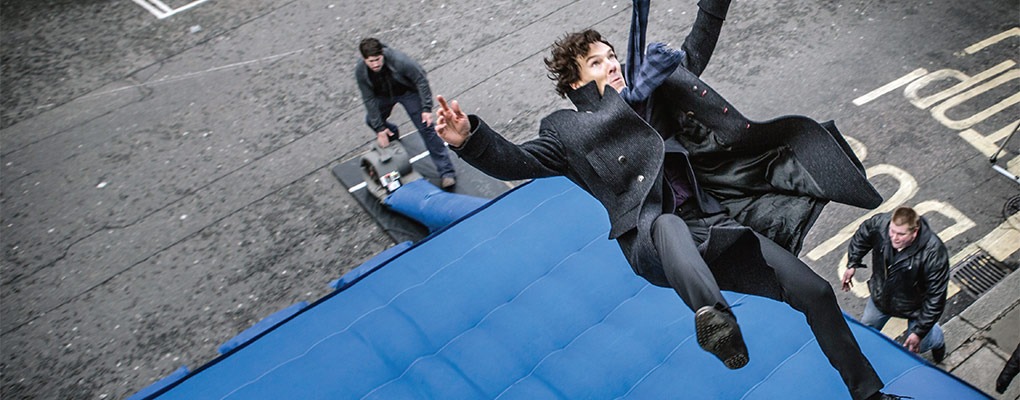Books
Sherlock Chronicles: The Reichenbach Fall
The BBC’s adaptation of Arthur Conan Doyle’s Sherlock Holmes is a seminal moment in crime drama history. So when we heard that BBC Books were bringing out the ultimate guide to the series we couldn’t resist dipping into it. Our first stop – finding out more about the end of series 2: the ultimate in cliff-hangers and visual trickery, the death of Sherlock Holmes.
In this extract from Sherlock Chronicles, writer Steve Thompson and Director Toby Haynes discuss the final scenes of the final episode of series 2, The Reichenbach Fall:
Where and when is the watercooler moment? That is one thing that we’re always looking for when we discuss the stories,’ Steve Thompson notes. ‘What’s everyone going to be talking about at work on Monday morning? Sherlock’s “death” was our ultimate water-cooler moment, really. We knew it would have a massive impact, but we never guessed quite how massive. For months afterwards, I’d be visiting schools and the first question, always, was “How did Sherlock come back to life?” And I couldn’t believe that web pages were being set up by The Times and The Guardian with everyone trying to work out how he’d done it. Some of those online discussions came close, and one or two had extra little ideas which were so clever we later added them into the mix to embroider what we already had.’
What they already had came from discussions with the illusionist Derren Brown and his team, in a meeting set up by Mark Gatiss. ‘Sue, Toby, Mark and I sat with these experts in illusion and got them to tell us how they thought we could do it.’
 ‘When I read it,’ recalls Toby, ‘I said, “He’s dead. There’s no way out.” We needed to have the solution in order to work out how to film it, so the film becomes an integral part of the stunt that Sherlock is pulling – I’m making the audience believe it, just as Sherlock is making John believe it. Derren Brown and his team showed us a stunt for somebody surviving jumping off a building. It was very simple: across the tower was a banner, just big enough to hide a slide. So we knew that the key thing was to obscure part of the relevant building.’
‘When I read it,’ recalls Toby, ‘I said, “He’s dead. There’s no way out.” We needed to have the solution in order to work out how to film it, so the film becomes an integral part of the stunt that Sherlock is pulling – I’m making the audience believe it, just as Sherlock is making John believe it. Derren Brown and his team showed us a stunt for somebody surviving jumping off a building. It was very simple: across the tower was a banner, just big enough to hide a slide. So we knew that the key thing was to obscure part of the relevant building.’
And in the earliest outlines for the script, the relevant building was going to be very different. ‘For a while, the episode was going to end with Sherlock being in the Shard as it was being built, and jumping off it to his apparent death. He was going to fall into some scaffolding on the side of the Shard and then a body would be dropped from the scaffolding – but there is no scaffolding on a building that size. Access would have been a problem: we knew what it was like trying to get into half-constructed buildings, the health and safety issues around getting film crews in. Also, if we’d got a stuntman to do this, he’s dead – there’s no way I could even fake that without an awful lot of computer-generated imagery, at the level of say the Avengers movie. Our feeling was that we didn’t want CGI getting in the way of the impact of Sherlock’s death. And we were going to be shooting in daylight, which would have exposed the CGI massively. So… did it have to be the Shard?
 ‘Around the same time, we went to St Bart’s hospital, because we had some scenes set there during the episode, and I thought it was actually as good as anywhere for the Fall. Not only was it high enough, but the roof was very good for filming: there were platforms that made it accessible. We could do the stunt of someone jumping off the roof to just six feet below because there were layers to the roof. And I was squinting up at the top of the building, picturing Sherlock standing on the edge, when I nearly got run over by this doubledecker bus that was swinging round. The location guy pulled me out of the way, and I watched the bus as it disappeared completely. In the middle of the parking area is this ambulance station, a very low building, only about the height of a garden shed, which created a roundabout for the buses to go round. Because of the angle that I was watching from and the size of the building, when the bus swung round the roundabout and parked by the bus stop it was completely obscured by this low building. It was like an optical illusion. I realised that this shed was big enough to hide a double-decker bus, and as soon as I realised that I knew that we had a chance in hell of making our own magic trick occur.
‘Around the same time, we went to St Bart’s hospital, because we had some scenes set there during the episode, and I thought it was actually as good as anywhere for the Fall. Not only was it high enough, but the roof was very good for filming: there were platforms that made it accessible. We could do the stunt of someone jumping off the roof to just six feet below because there were layers to the roof. And I was squinting up at the top of the building, picturing Sherlock standing on the edge, when I nearly got run over by this doubledecker bus that was swinging round. The location guy pulled me out of the way, and I watched the bus as it disappeared completely. In the middle of the parking area is this ambulance station, a very low building, only about the height of a garden shed, which created a roundabout for the buses to go round. Because of the angle that I was watching from and the size of the building, when the bus swung round the roundabout and parked by the bus stop it was completely obscured by this low building. It was like an optical illusion. I realised that this shed was big enough to hide a double-decker bus, and as soon as I realised that I knew that we had a chance in hell of making our own magic trick occur.
‘So I pitched the notion of using Bart’s to Sue, Steven, Mark and Steve. I put together a big package to sell the idea – and then everyone was much more open to it than I thought they were going to be, and I didn’t really need the big pitch!’
A few weeks later, Toby and the team converged on Bart’s for the recording. ‘We were supposed to do the stunt in the morning and then go and do the eight page conversation between Sherlock and Moriarty in the afternoon. In the end, we had to drop the whole roof conversation from the scheduled day of filming, because it was raining.’
‘The weather was so incredibly bad,’ Andrew Scott remembers, ‘that we just couldn’t film it, but we did manage to shoot some rehearsal footage. That meant that Benedict and I were able to take advantage of the fact that we had to do it again, to recalibrate how that scene should go. It’s the final showdown, which is based on the famous waterfall scene in the Doyle story, and it goes through lots of different elements. There’s the thriller factor to it, of course, and the mystery of how Sherlock pulls it off, but I think there’s also a real sense of forgiveness. I really liked the moment where we shake hands – the light was falling beautifully that second time we shot it. It’s the most beautiful bit of writing there too, you know.’


Please note: Moderation is enabled and may delay your comment being posted. There is no need to resubmit your comment. By posting a comment you are agreeing to the website Terms of Use.